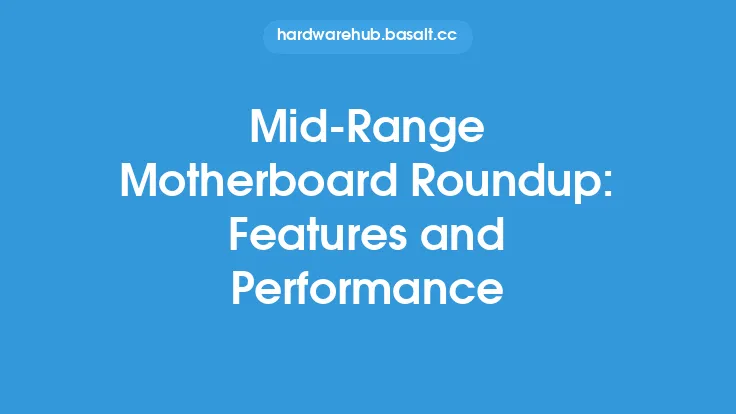When it comes to choosing a motherboard, one of the most critical components to consider is the chipset. The chipset is the brain of the motherboard, responsible for managing the flow of data between different components such as the CPU, memory, and peripherals. In this article, we will delve into the various features and capabilities of chipsets, helping you make an informed decision when selecting a motherboard for your needs.
Chipset Types
There are several types of chipsets available, each with its own strengths and weaknesses. The most common types of chipsets are Intel and AMD, which are designed to work with their respective CPUs. Intel chipsets, such as the Z390 and H370, are designed for use with Intel Core processors, while AMD chipsets, such as the X570 and B450, are designed for use with AMD Ryzen processors. Other types of chipsets include server-grade chipsets, such as the Intel C620 and AMD SP5100, which are designed for use in data centers and other high-performance applications.
Features to Look for in a Chipset
When selecting a chipset, there are several features to look for. One of the most important is the number of USB ports and SATA ports available. More USB ports and SATA ports provide greater flexibility and expansion options, allowing you to connect more devices to your system. Another important feature is the type of memory supported, such as DDR4 or DDR5. The speed and capacity of the memory also play a critical role in determining the overall performance of the system. Additionally, the chipset's ability to support multiple graphics cards, such as NVIDIA SLI or AMD Crossfire, is essential for gamers and graphics professionals.
Overclocking Capabilities
For enthusiasts and overclockers, the chipset's overclocking capabilities are crucial. A chipset with robust overclocking features, such as multiplier adjustment and voltage control, allows for greater flexibility and customization. The chipset's ability to support high-speed memory and CPU frequencies is also essential for achieving optimal performance. Some chipsets, such as the Intel Z390, offer advanced overclocking features like Extreme Tuning Utility (XTU) and Enhanced Dynamic Voltage and Frequency Scaling (EDVFS), which provide greater control over the system's performance.
Power Management and Efficiency
Power management and efficiency are critical aspects of a chipset's design. A chipset with advanced power management features, such as dynamic voltage and frequency scaling, can help reduce power consumption and heat generation. This is especially important for systems that require low power consumption, such as laptops and small form factor PCs. Some chipsets, such as the AMD X570, offer advanced power management features like Ryzen PowerNow! and Pure Power, which provide greater control over the system's power consumption.
Networking and Storage Capabilities
The chipset's networking and storage capabilities are also essential considerations. A chipset with built-in networking capabilities, such as Wi-Fi and Ethernet, provides greater flexibility and convenience. The type and number of storage interfaces, such as SATA, PCIe, and M.2, also play a critical role in determining the system's storage capabilities. Some chipsets, such as the Intel Z390, offer advanced storage features like Intel Optane and RAID support, which provide greater flexibility and performance.
Audio and Video Capabilities
The chipset's audio and video capabilities are also important considerations. A chipset with built-in audio and video capabilities, such as HD audio and 4K video support, provides greater flexibility and convenience. The type and quality of the audio and video codecs, such as Dolby Atmos and DTS:X, also play a critical role in determining the system's audio and video performance. Some chipsets, such as the AMD X570, offer advanced audio and video features like Radeon Vega graphics and 3D audio support, which provide greater performance and immersion.
Conclusion
In conclusion, the chipset is a critical component of a motherboard, and its features and capabilities play a significant role in determining the overall performance and functionality of the system. When selecting a motherboard, it is essential to consider the chipset's features and capabilities, including the number of USB ports and SATA ports, memory support, overclocking capabilities, power management and efficiency, networking and storage capabilities, and audio and video capabilities. By understanding the different types of chipsets and their features, you can make an informed decision and choose a motherboard that meets your needs and provides optimal performance.





